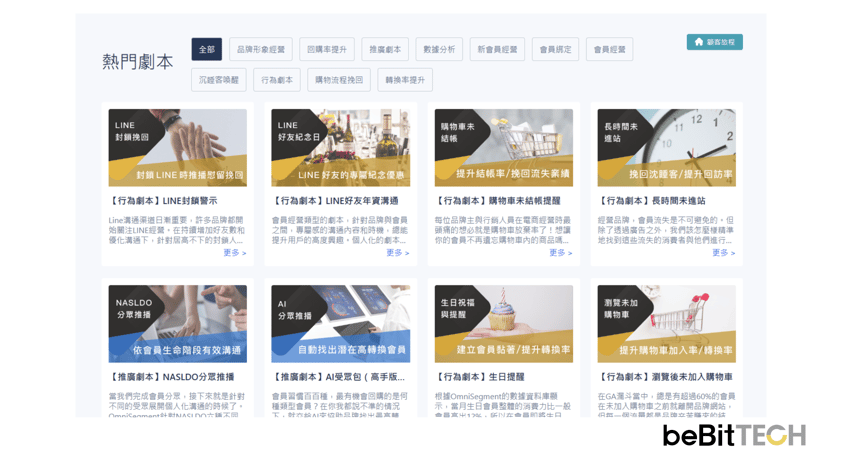As personalized marketing and customer experience become the focus for brand management in 2024, many brands are actively participating in omnichannel customer data integration and adopting automated marketing solutions. This trend has significantly accelerated the annual growth rate of Customer Data Platform (CDP) usage.
According to IDC research, by 2027, 62% of the Global 2000 companies will use data, analytics, and artificial intelligence to drive sales. In other words, businesses and brands will increasingly rely on more automated and flexible content editing, parameter tracking, and customer journey design to deliver highly relevant content to consumers in real-time, enhancing interaction as a new sales strategy. In the rapidly changing retail and e-commerce markets, CDPs have become essential tools for brands aiming to achieve sales growth. But what specific business challenges can a CDP address? How should CEOs, marketing decision-makers, and marketers choose the CDP that best fits their company and leverage it to deepen customer engagement?
this article will cover 6 key topics and 20 common cdp questions to help readers quickly understand the main applications and core values of cdps. By addressing these topics, brands can better respond to the challenges of the e-commerce environment, delivering sales strategies that combine efficiency and effectiveness. This article will provide essential CDP knowledge, starting from the basics and gradually delving deeper into advanced topics. For industry newcomers unfamiliar with CDPs, this article offers a step-by-step guide. For more experienced marketers and brand owners, you can use the table of contents below to navigate directly to sections of interest. Let's get started!
Table of Contents
I. Introduction to Basic CDP Applications
- What is a Customer Data Platform (CDP)?
- What are the Common Use Cases for CDPs?
- What are the Differences Between CDPs, CRMs, and DMPs?
II. Customer Data Integration and Analysis
- How Does a CDP Track and Integrate Customer Data Across Different Platforms?
- Which Channels Can a CDP Integrate Customer Data From? Can Data Be Imported or Exported Manually?
- Can a CDP Import Data from CRMs and Include Membership Levels?
III. Segmentation Functions and Models
- What Segmentation Models Are Available? Can They Track Changes in Segments Over Time?
- Can Built-In Segmentation Models Be Adjusted Based on Operational Goals?
IV. Marketing Automation Platform
- What Marketing Channels Can a CDP Use to Communicate with Customers?
- Can Marketing Materials Be Edited Directly on the CDP for Multi-Channel Campaigns (e.g., LINE, Email)?
- Does the CDP Offer Marketing Automation Templates? Can You Provide Some Examples?
- Can a CDP Deliver Personalized Marketing Push Notifications?
- Are There Features for Sending Marketing Messages to Anonymous Visitors Who Have Yet to Register?
- What AI Features Are Included in a CDP?
V. Business Intelligence Reporting
- What Is the Lookback Period for Recognizing Channel Effectiveness?
- How Is Channel Effectiveness Attributed?
- How Is ROAS (Return on Ad Spend) Calculated in a CDP System?
- Can Custom Metrics Be Viewed Directly in the System, or Must They Be Calculated and Imported?
VI. CDP Implementation
- Which Brands Are Suitable for Implementing a CDP? What Are the Assessment Criteria?
- What Are the Common Pricing Models for CDPs? How to Choose the Right CDP Vendor?
I. Introduction to Basic CDP Applications
1. What is a Customer Data Platform (CDP)?
A Customer Data Platform (CDP) is a digital service application that consolidates customer data and interactions from both online and offline channels, as well as various marketing touch points. This includes customer behaviors, preferences, purchase history, and more. By integrating this scattered data into a single, comprehensive database, a CDP provides businesses with precise data insights. These insights help brands enhance their marketing strategies, achieve highly personalized marketing, automate seamless sales processes, and improve the overall customer experience.
2. What Are the Common Use Cases for CDPs?
In the retail environment where customer experience is paramount, personalized and real-time marketing communication is the key differentiator for brands. A CDP can optimize e-commerce operations and expand potential sales opportunities through the following applications:
Data Integration and Analysis
A CDP consolidates data from online and offline channels and marketing touchpoints, integrating fragmented customer behaviors and preferences. This helps businesses to systematically and scalably analyze customer data, uncovering precise behavioral insights and enabling data-driven marketing strategy optimization.
Personalized Marketing Applications
With the built-in automated marketing workflows in a CDP, businesses can pre-plan communication strategies for each customer based on different sales scenarios and behaviors. When customers meet certain trigger conditions (such as clicking on a product page, not repurchasing for over two months, or adding items to the cart without checking out), the CDP automatically sends real-time marketing messages. This allows for personalized communication at scale without manual intervention.
Customer Experience Optimization
By establishing multi-channel marketing messages and communication modes through a CDP, businesses can offer consumers more flexible shopping processes that cater to diverse purchasing motivations. Additionally, by continuously gaining insights into customer needs and improving communication processes, brands can foster deeper and longer-lasting customer relationships through enhanced customer experiences.
3. What is the Difference Between CDPs, CRMs, and DMPs?
- CDP (Customer Data Platform): A marketing-oriented digital tool designed to integrate customer data from multiple channels, enabling personalized marketing and services.
- CRM (Customer Relationship Management): A business and customer service-oriented digital tool used for managing existing customer relationships, providing sales and after-sales service support.
- DMP (Data Management Platform): An advertising-oriented digital tool used for managing third-party data and deploying advertisements.
Combination 1: CDP + CRM = A More Comprehensive Customer Database
A CDP is not meant to replace a CRM. Instead, a CDP can integrate CRM customer data with behavioral interaction data from other channels, creating a more holistic customer profile. By combining a CDP with a CRM, businesses can gain a full-spectrum view of their customers, allowing marketing, sales, and customer service teams to manage customer relationships more effectively. This integration supports automated, precise predictions and personalized communication, maximizing the value of CRM applications.
Combination 2: CDP + DMP = A More Consistent User Experience
Integrating CDP data with a DMP can revolutionize advertising efforts. By combining the in-depth first-party data from a CDP with the broad third-party data from a DMP, brands can more accurately and diversely target audiences, enhancing the precision and ROI of ad campaigns. This cross-channel data sharing improves the likelihood of creating a consistent and coherent user experience, ensuring customers receive relevant information tailored to their interests and needs regardless of the channel. Additionally, the combined use of data analytics tools allows businesses to more accurately assess ad performance, making real-time strategic adjustments and optimizations to achieve more effective market penetration and higher marketing efficiency.

II. Customer Data Integration and Analysis
1. How Does a CDP Track and Integrate Customer Data Across Different Platforms?
When customers interact with a brand across various platforms, such as browsing an e-commerce website, viewing ads, or clicking on email promotions, these interactions generate data. A CDP leverages multiple technologies to track and integrate omnichannel data, allowing businesses to view and utilize this data from a single platform to maximize its value.
These technologies include:
- First-Party Cookies: When customers visit your website, cookies stored in their browser record their browsing behavior, shopping history, and membership information.
- Web Tracking Pixels: Often invisible, tiny image files embedded in emails or web pages. When these pixels are loaded, they automatically send visit information back to the server, helping track and analyze customers' online behaviors and engagement.
- UTM Parameters: By appending UTM parameters to URLs, CDPs can track the effectiveness of online ads and email marketing campaigns. These parameters provide essential information about the source, medium, and campaign name, aiding in accurately recording and attributing customer interactions.
- Device IDs: When customers use their mobile devices to browse digital content, manufacturers (such as Android and Apple) log the device's browsing history.
- Webhooks and APIs: These technologies allow CDPs to collect data in real-time from other applications (such as CRM systems and e-commerce platforms). Webhooks automatically send notifications when specific events occur, while APIs enable data exchange and integration between different systems.
2. What Channels Can a CDP Integrate Customer Data From? Can Data Be Manually Imported or Exported?
Depending on the vendor and the completeness of their integrations, the channels a CDP can consolidate may vary.
OmniSegment CDP can integrate customer data from multiple sources (both online and offline) to help brands build a comprehensive 360-degree customer profile. OmniSegment CDP can automatically and in real-time integrate data from various first-party channels, including e-commerce websites, apps, offline POS systems, CRM membership data, and LINE official accounts. Additionally, it supports manual import and export of customer data, ensuring high flexibility in data application.

3. Can a CDP Import CRM Data and Membership Levels?
When importing CRM customer data into a CDP for unified management, it is essential to ensure that the data fields in both the CRM and CDP align to facilitate seamless integration of the required customer information.
For example, if the CRM platform contains data fields such as 'Name', 'Phone Number', and 'Email', it is crucial to verify that the CDP also has corresponding fields for 'Name', 'Phone Number', and 'Email'. With OmniSegment CDP, the vast majority of CRM data fields and membership levels can be imported. This allows brands to view all marketing channel data directly within the CDP
III. Segmentation Functions and Models
1. What Segmentation Models Are Available? Can They Track Changes in Segments Over Time?
Common segmentation models include RFM (Recency, Frequency, Monetary), NAPL (New, Active, Passive, Lost), NASLD (New, Active, Sleep, Lost, Deep), and DCIU (Dormant, Casual, Interested, Uninterested). These models are constructed based on customer browsing behavior and personal data, helping brands classify customers into various groups according to different operational goals. This enables strategic planning, customer segment monitoring, and differentiated marketing applications.
OmniSegment CDP offers a high degree of flexibility in segmentation, allowing brands to set parameters based on online and offline transaction data, website behavior metrics, and customer purchase frequency. Brands can create various segmentation models tailored to their specific needs and objectives, ensuring precise targeting and effective marketing strategies.
Among these, the OmniSegment CDP's built-in NASLD model segments customers based on their activity levels. By categorizing customers into New, Active, Sleep, Lost, and Deep, brands can track changes in these segments over different time periods. For example, they can monitor how many new or active customers were added this month, or understand the contribution of each segment to the brand's revenue.

Through systematic segmentation, brands can assess whether their differentiated strategies are effectively impacting revenue. Long-term planning using these insights allows brands to continuously nurture high-value customer groups, ultimately enhancing operational efficiency.
- Continue Reading: How E-Commerce Can Quickly Leverage the RFM Model to Identify High-Value Customers
2. Can Built-In Segmentation Models Be Adjusted Based on Operational Goals?
OmniSegment CDP provides recommended segmentation model templates for brands, such as RFM (Recency, Frequency, Monetary) and NASLD (New, Active, Sleep, Lost, Deep), which are based on parameters like customer purchase frequency, repurchase cycle, and spending amount. However, considering the vast and diverse retail market, along with varying product characteristics and industries, OmniSegment CDP also supports customization. Brands can work with data strategy consultants to discuss their operational goals and design the most appropriate parameters, thereby maximizing the potential of the segmentation models.
IV. Marketing Automation Platform
1. What Marketing Channels Can a CDP Use to Communicate with Customers?
Using OmniSegment CDP as an example, brands can communicate with both anonymous visitors and registered members through various marketing channels to stimulate purchasing behavior. These channels include:
- Social Media: Facebook, LINE
- Personal Devices: Email, SMS, App notifications
- On-Site Communication: Pop-up windows, product recommendations
- Advertising Traffic: Target list packaging → GA4, Facebook
As customer journeys grow to be more diverse, leveraging a multi-channel marketing strategy can satisfy different consumption intents and needs. This approach helps brands effectively capture website traffic and strengthen sales momentum, ultimately enhancing the overall customer experience and driving conversions.
2. Can Marketing Materials Be Edited Directly on the CDP for Multi-Channel Campaigns (e.g., LINE, Email)?
Yes, with OmniSegment CDP, you can directly edit marketing materials for various channels such as LINE, Email, Messenger, SMS, and App notifications. Within these editing pages, brands can write copy, upload product images, and set different layouts and styles. Additionally, A/B testing can be conducted to determine the most effective marketing materials. This functionality eliminates the need to switch between multiple platforms and simplifies the editing process, making it more convenient to manage all marketing tools, providing a one-stop marketing solution.
3. Does the CDP Offer Marketing Automation Templates? Can You Provide Some Examples?
Yes, OmniSegment CDP includes built-in templates designed specifically for e-commerce, with over 50 data filtering conditions and more than 40 customer journey templates. These templates allow e-commerce brands to quickly launch automated marketing communications tailored to different marketing goals and sales scenarios without starting from scratch.

For example, Cha Tzu Tang uses OmniSegment CDP to send personalized birthday wishes and offers to customers, effectively deepening customer engagement. This approach ensures that the brand's service extends beyond the point-of-sales, creating a seamless and thoughtful experience before, during, and after the purchase.
Example of a Customer Journey Design:
1. Scheduling: Set up an 'automatic monthly messaging' schedule (e.g., for August birthdays).
2. Customer Selection: Select brand members who registered before August.
3. Personalized Messaging: Send personalized messages and offers based on 'membership level'.
4. Tracking: Tag sent messages for easy tracking and regular performance reviews.
By implementing this customer journey, Cha Tzu Tang did not only boost ROAS during promotional periods, but also achieved exceptional results through personalized communication, particularly enhancing the engagement with VIP members.

4. Can a CDP Deliver Personalized Marketing Push Notifications?
The ability of a CDP to deliver personalized push notifications depends on several factors, such as the integration of marketing channels, real-time data processing, and the granularity of customer journeys. OmniSegment CDP can assist brands in creating personalized marketing communications through the following features:
- 50+ Customer Behavior Filtering Conditions: Including registration, adding items to the cart, and browsing specific products.
- Built-in Customer Activity Models: Such as RFM and NASLD models.
- AI-Optimized Timing and Channel Selection
Taking into example OmniSegment CDP's popular abandoned cart customer journey template as example, it starts by filtering customers who have added items to their cart. The system then selects the main consumer segments from the NASLD model—New (N) and Active (A) customers. It sets a 30-minute timer and uses AI to automatically choose the best channel to send marketing messages to customers who have not completed their purchase. This real-time, personalized communication helps brands immediately stimulate purchase conversions and boost sales performance.

5. Are There Features for Sending Marketing Messages to Anonymous Visitors Who Haven't Registered Yet?
Converting anonymous visitors into brand members and encouraging them to make purchases requires timely and personalized communication. OmniSegment CDP offers two tools for on-site communication with anonymous visitors:
1. AI Pop-Up Windows: These pop-ups track each user's browsing behavior through device IDs and collect their website interaction data. Based on these behavioral events and product interactions, the system calculates similar indicators to make recommendations. Even for first-time visitors, the system can suggest popular products based on overall site behavior data, quickly stimulating and increasing purchase intent.
2. AI Product Recommendations: By monitoring browsing behavior and interactions with products, the system can offer personalized product recommendations, encouraging visitors to explore and purchase.
Additionally, OmniSegment CDP plans to launch a new Web Push feature in Q1 2024, which will focus on pre-purchase interactive communication. If anonymous visitors leave the site midway, the system will use their previous browsing behavior and preferences to send personalized notifications through the browser. This feature helps brands bridge communication gaps and achieve powerful 'anonymous personalization' marketing strategies.
- Continue Reading: Personalizing Product Recommendations with Just One Click — How AI Boosts E-Commerce and Increases Purchase Intent by 80%
- Continue Reading: Advanced Web Pop-Up Marketing Applications and Success Stories
VI. What AI Features Are Included in a CDP?
In recent years, the use of machine learning and AI-generated applications has become a major trend, significantly enhancing the efficiency of marketing resource allocation in CDPs through 'content generation' and 'automated marketing'.
Taking beBit TECH's OmniSegment CDP as an example, AI applications can be categorized into three main areas:
AI Content Generation: Streamlining The Process of Material Creation
- AI Copywriting: By inputting desired keywords (e.g., International Women's Day, promotion, face mask) and selecting the corresponding text length (50 words, 70 words, and 140 words) and tone, the system automatically generates ready-to-use marketing copy. If the generated copy's tone or content is unsatisfactory, users can regenerate the content to produce a new version.
-
AI Image Generation: Similar to the copywriting feature, marketers can input keywords into the system to generate corresponding product images. These images can be directly used in the editing pages for various channels within the system. This functionality allows marketers to bypass the tedious tasks of brainstorming copy and creating image materials, thus enhancing work efficiency.

AI Smart Filtering: Predicting High-Value Customer Segments and Optimal Communication Methods
-
AI Market Segmentation: OmniSegment CDP leverages the 'Dr. Kao AI' algorithm to predict customer transaction and browsing data. The system rates customers on a scale from 1 to 5 stars based on their likelihood of making a purchase within the next two weeks, with higher scores indicating a greater probability of purchase. This feature enables brands to quickly identify high-value customer segments and enhance sales conversions through real-time marketing push notifications.

AI Smart Delivery: OmniSegment CDP automatically records each customer's most frequently visited 'channels' and 'times'. By combining this data with the system's automated marketing applications, the CDP can communicate with consumers at the most suitable times through the most effective channels, optimizing message delivery performance.
AI Product Recommendations: Personalized Product Suggestions Across Different Placements and Channels
- Pop-Up Windows: The system triggers personalized product recommendation pop-ups based on customers' website browsing behavior (such as URLs visited and time spent on pages) and various product tags (e.g., customers who bought clothes but not shoes, active customers). This feature enables brands to engage both anonymous visitors and registered members deeply, effectively guiding customers towards making a purchase.
- Product Placements: In addition to using pop-up messages to drive immediate conversions, brands can implement AI product recommendations across various site locations, such as the homepage, product pages, and even the shopping cart page. This approach ensures that customer purchase intents are met at any time, providing a seamless shopping experience.
- EDM and LINE: Brands can also design diverse marketing materials within the system's built-in EDM and LINE editors. The integrated AI product recommendation feature allows for personalized product suggestions to be included directly in these communications, delivering tailored marketing messages to each customer.
V. Business Intelligence Reporting
1. What Is the Lookback Period for Recognizing Channel Effectiveness?
Using OmniSegment CDP as an example, unlike GA4, which typically sets conversion attribution lookback periods to 30, 60, or 90 days, OmniSegment CDP employs a more stringent '24-hour attribution recognition mechanism' to ensure precise attribution of channel effectiveness. By adopting this 24-hour attribution model, brands can regularly assess the contribution of the CDP system to their marketing performance, continually optimize their strategies, and maximize the value of the system implementation. This precise attribution helps in understanding the impact of each channel and refines the marketing approach for better results.
2. How Is Channel Effectiveness Attributed?
Following the previous question, OmniSegment CDP uses the 'last-click attribution' model for recognizing channel effectiveness. This means that the entire conversion value is attributed to the last channel the consumer clicked on before converting. Here are some examples to illustrate this:
- Path: 'E-commerce Website' > 'Email' > 'LINE' > 'Paid Search' → Attribution: 100% assigned to Paid Search
- Path: 'LINE' > 'Email' > 'Organic Search' > 'SMS' → Attribution: 100% assigned to SMS
- Path: 'Paid Search' > 'E-commerce Website' > 'LINE' > 'Email' → Attribution: 100% assigned to Email
3. How Is ROAS (Return on Ad Spend) Calculated in a CDP System?
Using OmniSegment CDP as an example, brands can directly view the ROAS performance for EDM, LINE, SMS, and App channels within the performance reports. Additionally, OmniSegment CDP includes a built-in metric for the contribution of OmniSegment CDP to overall online revenue, enabling a comprehensive evaluation of each channel and the CDP system's effectiveness in meeting expected outcomes. This serves as a strategic basis for long-term planning.
- Email ROAS Calculation: Revenue generated from emails sent via OmniSegment CDP / Cost of sending emails via OmniSegment CDP
- OmniSegment CDP Revenue Contribution: Revenue generated through OmniSegment CDP / Total online revenue

4. Can Custom Metrics Be Viewed Directly in the System, or Must They Be Calculated and Imported?
Using OmniSegment CDP as an example, the system is integrated with Tableau, allowing brands to set and monitor any custom metrics and parameters they wish to observe.
VI. CDP Implementation
1. Which Brands Are Suitable for Implementing a CDP? What Are the Assessment Criteria?
High Membership Volume: Total members or friends > 20,000
When a brand's total membership or friends list exceeds 20,000, it often faces challenges in personalizing communication due to insufficient marketing resources. Implementing a CDP can effectively organize customer profiles across different segments and utilize automated marketing communications to deliver personalized customer experiences. This approach enhances customers' willingness to revisit and boosts the brand's sales momentum.
Products or Services with High Repeat Purchase Rates
For products or services with an average repeat purchase cycle between 3 months and 1 year, and a total SKU count greater than 30, it is recommended to implement a CDP to deepen customer engagement. Brands can design automated customer journeys tailored to various marketing goals, sales scenarios, and member segments. The system continuously conducts automated communications with customers meeting diverse criteria, strengthening the repeat purchase intent of brand members and creating a sustainable sales growth flywheel.
2. What Are the Common Pricing Models for CDPs? How to Choose the Right CDP Vendor?
Renowned CDP vendors, both domestically and internationally, typically base their pricing on factors such as data transmission volume, number of members, and functionality modules. Taking beBit TECH's OmniSegment CDP as an example, they offer three different pricing tiers based on the size of the brand's membership: Entry-Level, Advanced, and Flagship. Member-based pricing is based on the number of members, which allows for the complete recording and retention of customer browsing behaviors and data across multiple marketing channels without increasing costs as data volume grows. This enables brands to accumulate more data assets while fully leveraging the potential and commercial value of customer data.
When selecting a CDP vendor, brands should evaluate the following five key points to ensure they meet their specific needs:
- Real-Time Data Processing and Scalability
- User Interface Ease of Use
- Localized Technical Support Team
- Information Security Certifications: ISO 27001 and ISO 27018
- Comprehensive After-Sales Consulting Services
OmniSegment CDP integrates multi-channel data while maintaining excellent scalability to handle large volumes of data. For automated marketing channels, such as SMS, EDM, LINE, Messenger, App-push, Web-popup, and more, the platform enables automated, personalized marketing and communication through a No-Code customer journey design.
Additionally, OmniSegment CDP holds ISO 27001 and ISO 27018 information security certifications and boasts a multilingual business team capable of addressing different language and cultural challenges. This support helps brands continuously optimize their e-commerce operations. OmniSegment CDP is not only highly regarded in the e-commerce sector, but is also a preferred choice for many retail industries when advancing OMO (Online-Merge-Offline) strategies.
Conclusion
In the new retail era, where customer journeys are increasingly fragmented across virtual and physical spaces, utilizing a CDP to manage complex customer data is not only a strategic application, but also an indispensable marketing tool. Many brands have been actively implementing CDPs to streamline their marketing efforts. This article addresses 20 common questions to elucidate the key advantages and applications of CDPs, helping readers quickly establish a foundational understanding of their value and potential.
For more information about OmniSegment CDP, feel free to visit our Blog Pages for additional contents,or click on the Contact Us button to get in touch with our team for personalized assistance.
beBit TECH is Asia's leading consulting technology company. As the iconic subsidiary of Japan's prestigious DX consulting company beBit Group, beBit TECH integrates an in-depth understanding of customer experience and cutting-edge yet user-centered technology.
With profound digital business strategies, the no-code designed AI customer data platform (CDP) and effective customer success insights, beBit TECH provides an all-in-one solution that includes consulting service, SaaS, and data analytics for DX and CX.
beBit TECH's vision is to create a Trillion Smile society.
Boost brand value and achieve sustainable growth with beBit TECH's AI-powered SaaS products, data consulting, and business strategy services.



